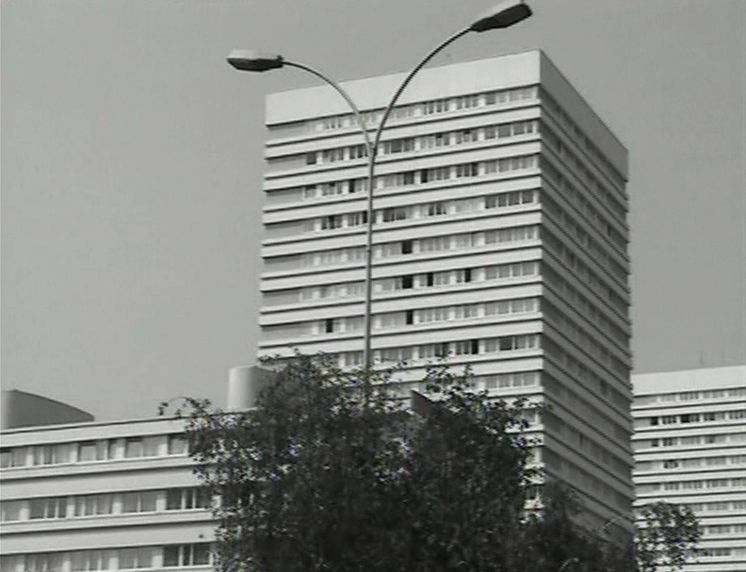
PETER DOWNSBROUGH

Peter Downsbrough
17 – 21 May 2024
2 – 6 pm
Exhibition opening and launch of KAMERA CAHIER N° 9, Thursday 16 May 2024, from 6 pm
Peter Downsbrough expresses himself with language, graphics, photography, film, video, installations and sculpture, investigating the traditional use of space and language as objects. His projects are methodical pursuits of the phenomena of passing from two to three dimensions and back again creating an experience which is visually conceptual, as well as corporal and visceral.He maintains a complex relationship with architecture and typography, while also drawing on the achievements of the early avant-garde (Bauhaus, De Stijl) and Minimal Art. In terms of form, his is highly rigorous and exhibits a powerful geometric sense, restricting itself primarily to the use of line, plane, negative space (cutting away), and delimitation. His material consists of black tape, adhesive letters and aluminum pipes, which create lines, planes, geometric forms or words: adverbs, prepositions or conjunctions (which connect one part of a phrase to another: and, but, as, of…).
Downsbrough’s artistic career began in the early sixties when he abandoned his architecture studies. Since then, his artistic process is centered around questions regarding the “position” and “displacement” of objects, and people within a determined space, such as the constructed and concrete space of an exhibition gallery, of vernacular and industrial architecture, a book, or even a city.
His photographic and video works are explorations of how space is structured and organized. In the early 1970s Peter Downsbrough used photography in order to document the different view points of his sculptural work and used serial photography in order to document the space and perception according to the different movements of the spectator as exemplified by his first book which contained photographs, “Two Pipes Fourteen Locations”, 1974. In the mid-seventies, he started to work with video. His intention was not to produce spectacular, or sublime, images but rather to explore the relationship between time and place by using the camera’s viewfinder as a structuring tool, by never cropping his images post-exposure and by avoiding metaphorical illusions by not giving titles to his photographs, thus only naming them by giving the place and date, as their reference, in the style of a traveling diary. In 1980, he rented commercial space on the Spectacolor Board on Times Square in New York to put up a piece called The Dice, which made him one of the first artists to use that space. This showing was documented in the film 7 come 11, one of his only films that uses color.
The use of black and white is in fact a fundamental characteristic of Downbrough’s work. In his words, “black is the most dynamic, it makes structure evident and avoids subjective elections. We think in black and white.”
From 2000, his plastic language is refined even further and the artist only films urban settings of contemporary society, almost or completely bereft of people, which have increasingly become our most “natural” environment and thus where structures, time and space make themselves more evident to our eyes.
Peter Downsbrough (New Jersey, US, 1940) lives and works in Brussels (Belgium). He is represented by Angels, Barcelona; Krakow Witkin Gallery, Boston; Thomas Zander, Cologne. His films are distributed by Argos Centre for audiovisual, Brussels. Since 1972, Peter Downsbrough has been exhibiting regularly in the United States and Europe.
[text source: Angels, Barcelona. For additional information, CV, bibliography and a full list of exhibitions, please click below]
Program
PETER DOWNSBROUGH
Friday 17 – Tuesday 21 May 2024 (Sunday closed)
2 – 6 pm
Opening Thursday 16 May 2024, from 6 pm
WHERE:
Labor Neunzehn
Kiefholzstr.19/20
12435 Berlin
LIMITED PLACES, register to reserve your place (free) here: EVENTBRITE
This event is kindly supported by Dezentrale Kulturarbeit Berlin-Treptow.
![]()
video works:
And Align, 14:03 min, b/w, sound, u-matic, 1976
A place to be, 26:46 min, b/w, sound, u-matic, 1977
7 come 11, 4:12 min, color, sound, 16mm, 1980
Now With in Three Parts, 6:05 min, color, sound, u-matic, 1983
PASS-ING], 12:20 min, b/w, sound, digital, 2002
AND, 11:08 min, b/w and color, sound, dvcam, 2004
HERE, 12:55 min, b/w and color, sound, dvcam, 2004
AS…, 11:56 min, b/w and color, sound, dvcam, 2004
AND [BACK, 4:37 min, b/w, sound, dvcam, 2005
OPEN ]ING, 7:57 min, b/w, sound, dvcam, 2005
ET[-, 6:07 min, b/w, sound, digital, 2008
AND TO, 3:01 min, b/w, sound, digital, 2018
cahier n°9
Peter Downsbrough.
associated with major international art movements such as minimal art, conceptual art, and visual poetry, his work spans across various mediums including sculpture, wall pieces and room pieces, books, work on paper, photography, film, and video. – the work, which has affinities with architecture and typography, explores the traditional use of space and language, while criticizing power structures, e.g. urbanism, that influence social interactions and shape the landscape. – using mostly black and white and a reduced visual vocabulary such as words, lines, and geometric figures, his artistic process offers a reflection on the notions of position, framing, displacement, and interstitial spaces.

designed by
Peter Downsbrough.
curated and published by
AVARIE and Labor Neunzehn.
typeface
Magister by Aldo Novarese, 1966.
cover in letterpress
by Archivio Tipografico, Turin.
This program is generously supported by Dezentrale Kulturarbeit Berlin-Treptow















